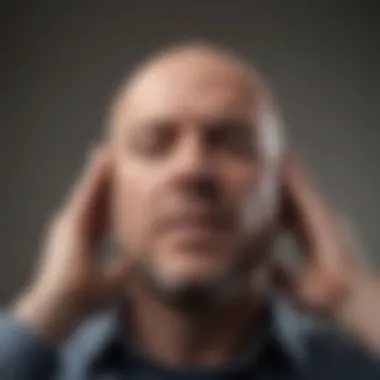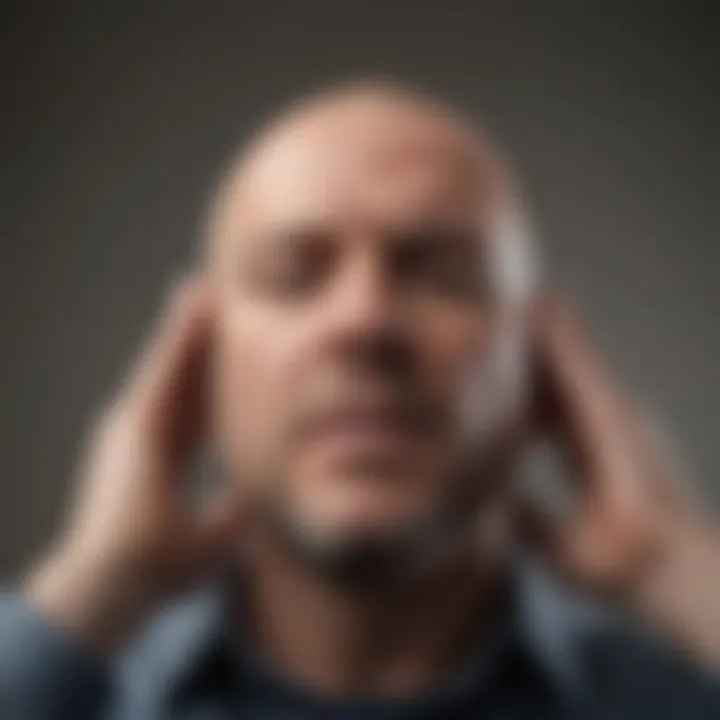Understanding Migraine Disease: In-Depth Insights


Article Overview
Migraine disease is more than just a headache; it is a complex condition influencing countless individuals around the globe. Understanding its layers becomes essential for everyone, from healthcare professionals to daily sufferers. This article seeks to delve into several elements surrounding migraine disease such as its underlying mechanisms, triggering factors, treatment avenues, and broader socio-economic effects. By addressing these topics meticulously, we hope to equip readers with a well-rounded perspective of migraine disease.
Purpose of the Article
The primary aim here is to provide an exhaustive exploration into the world of migraine disease. It is a multi-dimensional topic that covers not just the clinical aspects but also the personal experiences of those affected. By demystifying this neurological condition, we intend to foster a more profound awareness that could lead to better management strategies and healthcare responsiveness.
Relevance to Multiple Disciplines
The implications of migraine disease extend far beyond healthcare. This article is particularly relevant to:
- Healthcare Providers: Deepening their understanding can improve patient outcomes.
- Researchers: Encouraging exploration into novel therapies and triggers.
- Educators: Informing curriculum that addresses chronic illness.
- Policy Makers: Highlighting socio-economic impacts to facilitate better public health strategies.
Research Background
To appreciate the current outlook on migraine disease, one must first grasp the historical context and foundational concepts.
Historical Context
Migraine has been described throughout history in various forms, from ancient texts to modern research. Early references can be seen in writings from Hippocrates, who recognized a distinction between headaches and migraines. In the centuries that followed, frameworks to understand this condition evolved, but it wasn’t until the late 20th century that recognizably advanced research even began bringing clarity into its pathophysiology.
Key Concepts and Definitions
Understanding specific terms is paramount when tackling migraine disease. Here are a few key definitions:
- Migraine: A recurrent headache disorder that typically presents as unilateral and pulsating, often accompanied by nausea, vomiting, and sensitivity to light or sound.
- Aura: Symptoms that precede or accompany migraine, can include visual disturbances or sensory changes.
- Triggers: Specific stimuli that can provoke a migraine attack; these may vary from individual to individual and include stress, certain foods, and hormonal changes.
"Migraine disease may appear elusive, but its effects are tangible and profound."
"Migraine disease may appear elusive, but its effects are tangible and profound."
Grasping these concepts lays the groundwork for a deeper dive into the nuanced characteristics of migraine disease, which we will explore further in the following sections. By understanding its historical development and foundational definitions, readers can appreciate the complexities that will be unfolded later.
Defining Migraine Disease
Defining migraine disease is crucial as it lays the groundwork for understanding this complex condition that affects countless individuals. Without a clear understanding, efforts to manage and treat the disease can become convoluted, leaving many still in the dark.
A proper definition does not simply categorize migraines based on symptoms alone; it unravels the layers behind what makes migraines distinct from other headache disorders. Going beyond the medical jargon, defining migraine disease also serves to educate sufferers about their experiences. Grasping the intricacies of migraine pathology empowers individuals to take proactive steps in their management journey. Moreover, it opens up discussions regarding societal perceptions, stigma, and the varying experiences of those impacted by migraines.
Historical Perspective
The history of migraine is as old as humanity itself, with references dating back to ancient civilizations. The Greek physician Hippocrates, often heralded as the "father of medicine", wrote about headache disorders, including migraines, as early as the 5th century BC. People in ancient Egypt documented their experiences with what we now recognize as migraine symptoms, from intense headaches to nausea. They viewed these episodes through a lens of mystical or divine influence, attributing them to emotional disturbances or even displeased deities.
As time moved forward, the understanding of migraines evolved. In the Middle Ages, migraines were often linked to demonic possession or witchcraft, reflecting the deeply embedded cultural beliefs of the time. Fast forward to the 19th century, and significant strides were being made in medical research. Doctors began to classify migraine symptoms more systematically, recognizing them as neurological rather than mystical.
"History teaches us that the understanding of migraine has changed dramatically, paralleling shifts in medical practices and societal attitudes."
"History teaches us that the understanding of migraine has changed dramatically, paralleling shifts in medical practices and societal attitudes."
Current Medical Definition
Presently, migraine is classified as a neurological disease characterized by recurring episodes of headache, typically unilateral and pulsating in nature. The International Classification of Headache Disorders provides a framework for distinguishing between different types of migraines, emphasizing the patterns and associated symptoms.
According to the latest research, migraines can be differentiated into various categories including migraine without aura, migraine with aura, and chronic migraine. An aura can consist of visual or sensory disturbances that precede the headache, affecting the individual’s sight or touch—a hallmark defining element of certain migraine types.
Additionally, the recognition of other symptoms such as sensitivity to light, sound, and sometimes smell has become part of the comprehensive medical definition. This allows healthcare professionals to understand better the full impact migraines can have on a person’s capacity for daily activities and overall quality of life.
This ongoing evolution in defining migraine disease not only enhances diagnosis and treatment approaches but also shapes the conversations around awareness and understanding of the disease, set against a backdrop of personal stories and societal perceptions.
Pathophysiology of Migraine
Understanding the pathophysiology of migraine is central to grasping how this condition affects individuals on a physiological level. It ain't just about the pain; it’s a complex interplay of biological processes that triggers migraine attacks. This section investigates the underlying mechanisms that create the conditions for migraines, offering insight into why they happen, which can ultimately aid in better management strategies.
Neurovascular Mechanisms
Migraine isn't merely a headache. It is a neurological disorder characterized by a dysfunction in the neurovascular systems. The cerebral blood vessels and nerve pathways are at the forefront of this. When a migraine strikes, there's a cascading effect: the blood vessels initially constrict, reducing blood flow, but then dilate significantly, leading to the intense pain associated with attacks. This process is often explained by the concept of cortical spreading depression—a wave of depolarization that moves across the cortex. Think of it like a ripple effect on a still pond.
During this ripple, neuropeptides such as calcitonin gene-related peptide (CGRP) and substance P are released, which further contribute to inflammation and increased pain sensitivity. This neuroinflammatory response is crucial; it explains why migraines are not just a one-time occurrence but can become chronic for some individuals.
"Migraines are not merely an inconvenience; they represent a disruption in the very fabric of neurological and vascular health."
"Migraines are not merely an inconvenience; they represent a disruption in the very fabric of neurological and vascular health."
Moreover, it’s worth noting that this intertwining of neural and vascular responses creates a perfect storm—environmental triggers, coupled with genetic predispositions, can unleash a series of neurovascular events leading to a migraine. In essence, understanding these mechanisms brings clarity to treatment approaches that focus on either aborting an impending attack or preventing them from happening.
Genetic Factors
Genetics plays a significant role in an individual's susceptibility to migraines. It's not just about whether you have them, but how they manifest and respond to treatments. Research has shown that specific genetic markers can increase the likelihood of experiencing migraines. For instance, variations in genes like TRPV1 and SLC24A3 have been linked to the condition.
- Familial Hemiplegic Migraine (FHM): This is a rare form of migraine with a strong genetic basis. Families with a history of FHM often experience episodes that are not only more severe but can also include temporary paralysis.
- Common Migraine Genetic Markers: Although not as pronounced, other common migraine types have genetic underpinnings as well.
The idea that migraine can have a hereditary aspect tends to resonate deeply with those affected. It can be both reassuring and disheartening; for some, it is a relief to know that there's a genetic basis, but on the other hand, it can feel unavoidable.
As medical research continues, there remains hope that a deeper dive into these biological factors will pave the way for innovative therapeutic approaches, assisting those tired of facing the debilitating nature of migraines.
Classification of Migraine
The classification of migraine is crucial in establishing a clearer understanding of how this complex disease manifests and impacts individuals differently. Recognizing the various types of migraine is fundamental for both diagnosis and treatment, as each classified type may respond uniquely to different therapeutic approaches. Moreover, a nuanced classification aids healthcare providers in tailoring treatment plans to align more closely with patients' specific experiences. This discernment promotes the effectiveness of interventions and enhances the quality of life for those affected.
With a better grasp of migraine classification, patients, medical practitioners, and researchers can foster a more effective discourse around this often-misunderstood condition. Delving into the types of migraine reveals distinct characteristics that can greatly influence clinical management and patient education.
Migraine Without Aura
Migraine without aura is the most common form of this neurological condition, accounting for about 70-75% of migraine cases. This type typically presents as a pulsating headache that can last from 4 to 72 hours, often accompanied by nausea, vomiting, and sensitivity to light and sound. The pain usually localizes on one side of the head, but it can sometimes affect both sides.
The absence of aura does not diminish the intensity of the headache; it can still severely disrupt daily activities and impact a person's well-being.
The absence of aura does not diminish the intensity of the headache; it can still severely disrupt daily activities and impact a person's well-being.


Some common triggers for migraine without aura include:
- Stress or anxiety
- Hormonal changes, especially in women
- Lack of sleep or disrupted sleep patterns
- Environmental factors like bright lights or strong smells
Understanding this classification helps patients recognize patterns in their headaches, enabling them to avoid triggers and manage symptoms more effectively.
Migraine With Aura
Migraine with aura, although less common, is characterized by sensory disturbances that precede the headache. These aura symptoms might include visual changes such as seeing flashes of light or zigzag patterns, sensory changes involving tingling of the limbs, or even speech difficulties. Auras can occur as early as 10-30 minutes before the headache begins and typically last from a few minutes to an hour.
This form can be particularly alarming, as the neurological symptoms may mimic strokes or other serious conditions. Therefore, clarity on migraine with aura is vital for timely and appropriate treatment, helping to differentiate it from other conditions that could present similarly.
Each individual's experience of aura can vary, with some reporting visual disturbances quite elaborately while others note tingling sensations. This variability emphasizes the importance of identifying personal migraine patterns for better management.
Chronic Migraine
Chronic migraine is distinct from episodic forms, diagnosed when an individual experiences headaches on 15 or more days per month over three months, with at least eight of those days meeting criteria for migraine. This condition can significantly impair quality of life, as the frequency of attacks escalates the burden on individuals.
In chronic migraine, the attack may evolve; over time, the headaches can become more consistent and debilitating. Some may experience additional symptoms, including increased tension or fatigue, as they live with the condition daily.
The treatment for chronic migraine often requires a multi-faceted approach, including:
- Preventive medications, such as beta-blockers or anticonvulsants
- Lifestyle modifications, like improved sleep hygiene
- Counseling or support groups to provide emotional and psychological support
By emphasizing these classifications—migraine without aura, migraine with aura, and chronic migraine—this article illustrates the varied nature of migraine disease. This understanding of classification not only improves patient awareness but also informs therapeutic strategies, aligning them more closely with individual needs.
Symptoms and Diagnostic Criteria
Understanding the symptoms and diagnostic criteria for migraine disease is crucial. Recognizing these elements helps in distinguishing migraines from other types of headaches and neurological conditions. This knowledge can significantly influence treatment decisions and improve the quality of life for those affected.
Primary Symptoms
Migraines can present themselves through a myriad of symptoms, the hallmark being a unilateral, pulsating headache of moderate to severe intensity. Typically, these headaches are exacerbated by routine activities and can last anywhere from four hours to several days. An individual might also experience:
- Nausea: This can often be accompanied by vomiting, making it difficult to keep food down.
- Sensitivity to Light and Sound: Often, people seek a dark, quiet room to help alleviate the discomfort.
- Aura Symptoms: About 25% of migraineurs experience transient neurological symptoms, known as aura, which can include visual disturbances, tingling sensations, or even temporary loss of vision.
It's imperative for individuals to be aware of these symptoms. Early recognition can prompt timely intervention, potentially short-circuiting the escalation of a migraine attack.
Diagnostic Challenges
Diagnosing migraines often poses significant challenges, both for healthcare providers and patients. The complexity lies mainly in the subjective nature of symptoms and the requirement for specific diagnostic criteria. A few complexities may arise:
- Misdiagnosis: Migraines can be mistaken for tension-type headaches or cluster headaches which leads to inappropriate treatment choices.
- Symptom Overlap: Some individuals with migraines may experience symptoms that overlap with other conditions like sinusitis or temporomandibular joint disorders.
- Varying Presentation: Not all migraines present the same way. Some individuals might showcase atypical symptoms that deviate from the classical presentation, adding another layer of difficulty.
"A definitive diagnosis of migraine disease greatly relies on a detailed medical history and symptom journal, often aided by a healthcare professional's understanding of a patient's unique presentation."
"A definitive diagnosis of migraine disease greatly relies on a detailed medical history and symptom journal, often aided by a healthcare professional's understanding of a patient's unique presentation."
Furthermore, diagnostic guidelines suggest the International Classification of Headache Disorders, defining clear criteria that must be met for a migraine diagnosis. However, variability in symptoms means that individuals may not meet the criteria. This inconsistency can lead to chronic misinterpretation by health professionals, hence the necessity for increased awareness and improved educational resources on the subject.
Triggers of Migraines
Understanding the various triggers of migraines is pivotal to grasping the disease's complex nature. Identifying these triggers can empower individuals to better manage their migraine experience, potentially leading to an improvement in their overall quality of life. By being aware of the elements that can prompt a migraine attack, sufferers can make informed lifestyle choices that could minimize frequency and severity. This knowledge is especially important considering that migraine triggers can vary widely from person to person, making personal observation and adaptation essential.
Environmental Factors
Environmental factors encompass a wide range of stimuli that can contribute to migraine onset. Factors such as changes in weather, exposure to bright lights, or strong odors often top the list of common triggers. One might experience a sudden change in temperature or humidity, which could lead to discomfort. For instance, a drop in barometric pressure might make someone susceptible to a migraine; the weather feels as if it's shifting gears, altering the body’s equilibrium. Here’s what to look for:
- Barometric Pressure: Sudden drops can create an imbalance in the body's systems.
- Bright Lights: Fluorescent lights or direct sunlight might overwhelm a sensitive nervous system.
- Strong Odors: Perfumes, cleaning products, or smoke can evoke discomfort and trigger an attack.
Research indicates that determining your environmental triggers can aid in developing a proactive strategy for migraine management. Creating a controlled environment, wherever practical, can drastically reduce your exposure to these triggering aspects.
Dietary Influences
Dietary influences also play a significant role in migraine management—a concept that cannot be ignored by those suffering from this condition. What we eat and drink can impact not just our health but also our susceptibility to migraine attacks. Some common dietary triggers that many people may not realize include:
- Caffeine: While caffeine can be helpful in alleviating headaches for some, for others, it can trigger an attack if consumed in excess or withdrawn suddenly.
- Aged Cheeses and Processed Meats: These foods often contain tyramine, a compound that may contribute to migraines.
- Alcohol: Particularly red wine, can lead to migraines due to its various components.
Monitoring food intake and maintaining a consistent meal schedule can foster a healthier relationship with food and potentially mitigate the risk of migraines. Keeping a food diary can help identify particular food items that correlate with increased migraine frequency.
Lifestyle Factors
Lifestyle factors are immensely influential for individuals who suffer from migraine disease. Certain daily habits can either exacerbate or alleviate symptoms, thus playing a critical role in one’s personal management plan. Here are some lifestyle factors worth considering:
- Sleep Patterns: Irregular sleep schedules can lead to increased migraine incidents. It's essential to maintain a regular sleep routine, ensuring adequate rest.
- Stress Management: Prolonged stress levels can lead to tension-type headaches and provocation of migraines. Utilizing relaxation techniques such as meditation or yoga can be beneficial.
- Physical Activity: Regular exercise has been shown to reduce headache frequency; however, overexertion can also trigger migraines. Finding the right balance is key.
Adopting a holistic approach—considering environmental, dietary, and lifestyle factors—can carve a path toward better management of migraines. Integrating the knowledge of these triggers into daily life can offer individuals greater empowerment over their condition.
Impact on Quality of Life
The impact of migraine disease on individuals extends far beyond the physical symptoms. It's a complex web that weaves through various aspects of life, affecting how people live, interact, and function in their daily routines. Understanding these implications is essential for grasping the overall burden of this neurological condition on sufferers.
Personal and Social Dimensions
Living with migraines can be like trying to dance to a rhythm that constantly changes. For many, the personal toll is profound. The unpredictability of attacks forces individuals to tread carefully in both social and personal spheres. Plans may be made and then dashed at a moment's notice if a migraine strikes. This unpredictability can lead to frustration and social withdrawal. Friends and family might not fully grasp the plight of a person suffering from migraines, often labeling them as unreliable or simply as 'not trying hard enough'.
Here are some key personal and social impacts:
- Isolation: Many migraine sufferers find themselves distancing from social gatherings, fearing an impending attack. The anxiety can be palpable, leading to further withdrawal.
- Relationships: Disruptions caused by migraines can strain relationships with loved ones. Misunderstandings arise, creating rifts that can last longer than the migraine itself.
- Workplace Challenges: For those in professional settings, the ability to meet commitments frequently falters. Colleagues may see frequent absences as a lack of dedication.
"Understanding the emotional and social dynamics of living with migraine disease is just as critical as addressing the physical symptoms."
"Understanding the emotional and social dynamics of living with migraine disease is just as critical as addressing the physical symptoms."
Economic Burden
The economic implications of migraine disease add another layer of complexity to its impact on quality of life. It’s not just about pain; there are tangible costs that ripple through various sectors of society. Individuals often face direct costs related to treatment, alongside indirect costs stemming from lost productivity.
Here are some facets of the economic burden associated with migraines:


- Medical Expenses: Regular visits to doctors, prescriptions for abortive medicines and preventive therapies can accumulate quickly. The financial strain can be considerable, making it challenging for some to afford necessary treatments.
- Lost Work Days: Frequent attacks can lead to missed days at work. According to research, sufferers miss approximately 7 to 8 workdays per year on average, leading to diminished earnings and professional growth.
- Impact on Employers: Companies also bear a weighty burden. The direct costs in terms of lost productivity and healthcare expenses further complicate the overall economic picture.
In summary, the quality of life for individuals living with migraines is influenced by a myriad of factors—from social interactions to economic challenges. Understanding these elements is crucial for both individuals and healthcare providers in navigating the often turbulent waters of migraine disease.
Treatment Options
In the realm of migraine disease, treatment options stand as a beacon of hope for those caught in the grips of relentless pain. The potential to alleviate symptoms and enhance quality of life is what drives continual research and development in this area. Treatment strategies can be broadly classified into two categories: acute treatment strategies aimed at relieving symptoms during a migraine attack, and preventative therapies designed to reduce the frequency and severity of these occurrences. Understanding these approaches is crucial not only for patients but also for healthcare professionals seeking effective interventions.
Acute Treatment Strategies
Acute treatment strategies are crucial for managing migraines as they focus on the immediate relief of symptoms once a headache begins. These treatments are often tailored to the individual, with the choice depending on the frequency and severity of the attacks, as well as the patient's overall health and existing conditions.
- Medications: Over-the-counter pain relievers such as ibuprofen and acetaminophen can often be effective, particularly for mild migraines. However, prescription medications may be necessary for more severe cases. These include triptans like sumatriptan, which specifically target the pathways involved in migraine attacks.
- Ergots: For some patients, ergotamine medications can be extraordinarily effective, especially if taken at the onset of a migraine. These helps constrict blood vessels, a mechanism that has proven beneficial.
- Nausea Management: In tandem with headache relief, managing associated symptoms like nausea is vital. Medications like ondansetron can help mitigate this aspect, allowing patients to focus on alleviating their headache.
- Non-Pharmacological Interventions: Techniques such as applying cold compresses can provide additional comfort. Some individuals may find relief through relaxation techniques or acupuncture, adding another layer to the acute management strategy.
"The goal is not just to eliminate pain but to reclaim the ability to function normally."
"The goal is not just to eliminate pain but to reclaim the ability to function normally."
Preventative Therapies
Preventative therapies serve as long-term strategies designed to minimize the frequency and intensity of migraine attacks. These approaches require a more nuanced view of the individual’s health and often involve multidisciplinary care that takes the patient's history and lifestyle into account.
- Daily Medications: Various medications can serve to prevent migraines when taken regularly. These include blood pressure medications like beta-blockers (e.g., propranolol) and anticonvulsants (e.g., topiramate) that have been shown to help with reducing the frequency of migraines.
- Botulinum Toxin Injections: For chronic migraine sufferers, botulinum toxin injections can provide significant relief, being administered every few months to interrupt the cycles of migraine progression.
- Cognitive Behavioral Therapy: Beyond medication, therapy can play an integral role. Cognitive behavioral therapy helps patients identify and modify their response to triggers, ultimately providing strategies to manage stress and lifestyle changes more effectively.
- Lifestyle Adjustments: Encouraging a balanced diet, regular exercise, and sufficient sleep can make a remarkable difference. Avoiding known triggers, like excessive caffeine or certain foods, also factors prominently into preventative strategies.
- Nutraceuticals: Some patients report benefits from supplements such as magnesium, riboflavin, or coenzyme Q10, having demonstrated potential for reducing migraine frequency.
Understanding the landscape of treatment options for migraine disease encompasses a blend of acute response strategies and proactive preventative measures. By further exploring these avenues, patients can work toward reducing the burden of migraine disease on their daily lives, affirming that while migraines may be a formidable adversary, effective management is within reach.
Emerging Therapies
As we navigate the complex landscape of migraine disease, the spotlight increasingly lands on emerging therapies. These novel interventions promise to offer new avenues for treatment, enhancing management strategies to better address the unrelenting nature of migraines. With this evolving panorama, it’s crucial to scrutinize the potential benefits, practical considerations, and the implications for patients and healthcare providers alike.
Novel Pharmaceuticals
Recent years have witnessed a surge in the development of novel pharmaceuticals specifically aimed at alleviating migraine symptoms. One such breakthrough is the introduction of CGRP (Calcitonin Gene-Related Peptide) antagonists, which have exhibited remarkable efficacy in both acute and preventive treatment settings. These medications target the neuropeptides involved in migraine pathophysiology, providing targeted relief where traditional options sometimes fall short.
Moreover, other pharmaceutical advancements include the integration of small molecule drugs that can potentially decrease the frequency and severity of migraine episodes. Their unique mechanism hinges on modulating neurotransmitter activity, thus offering personalized treatment based on an individual's distinct migraine profile.
However, it is important to consider the implications of these therapies. New drugs often come with various side effects, which necessitates a brief but critical discussion with patients about expectations and potential adverse reactions.
Neuromodulation Techniques
The rise of neuromodulation techniques represents another horizon in migraine management. This modality entails the use of electrical stimulation to alter nerve activity, aiming to disrupt the migraine pathway before it gets a foothold. Methods such as transcutaneous electrical nerve stimulation (TENS) and occipital nerve stimulation have opened doors to approaches that can be tailored to individual needs.
Among these, external trigeminal neurostimulation has gained attention for its non-invasive nature and the growing body of evidence suggesting it can mitigate migraine frequency and intensity. Patients appreciate the opportunity to explore these alternatives, especially when they are resistant to traditional pharmacological treatments.
Neuromodulation not only provides a means to break the cycle of pain but also helps in retraining the brain's response to pain, offering a glimmer of hope for those who suffer chronic migraines.
Neuromodulation not only provides a means to break the cycle of pain but also helps in retraining the brain's response to pain, offering a glimmer of hope for those who suffer chronic migraines.
Alternative Approaches to Management
When dealing with a condition as intricate as migraine disease, exploring all avenues for relief becomes essential. While medications and traditional therapies are the backbone of treatment, alternative approaches provide a complementary course that can enhance quality of life for many individuals. These methods can be beneficial not only for managing symptoms but also for fostering a proactive attitude towards migraine management. Understanding these alternatives can arm patients with valuable tools in their journey, bridging the gap where conventional treatments may fall short.
Cognitive Behavioral Therapy
Cognitive Behavioral Therapy (CBT) is an alternative approach gaining traction among migraine sufferers. This therapeutic method hinges on the concept that our thoughts significantly influence our emotions and behaviors. For migraine patients, CBT teaches coping strategies to manage stress and modify thought patterns that could trigger migraine episodes.
- Benefits of CBT
- Stress Reduction: Many migraine attacks are precipitated by stress. CBT's focus on managing stress can lead to fewer migraines.
- Empowerment: Patients learn to recognize patterns and triggers, giving them more control over their condition.
- Long-term Skills: Individuals can use the techniques learned in CBT to manage not just migraines but a range of life’s challenges.
However, it’s worth mentioning that CBT requires commitment. Regular sessions and practice of skills learned are crucial, but many find the effort worth it in light of improved headache management. CBT might feel like a tall order for some, but it ultimately promotes a mindset shift that can lead to lasting change.
Dietary Adjustments
Diet plays a pivotal role in many people's experiences with migraine disease. Certain foods can act as triggers or, conversely, can be part of a beneficial lifestyle that diminishes migraine frequency and severity.
Making conscious dietary adjustments can transform what seems to be an unavoidable reality into a more manageable one. Here are some specific strategies:
- Identify and Avoid Trigger Foods: Common culprits include aged cheeses, processed meats, and certain alcoholic drinks like red wine. Keeping a food diary can help pinpoint which foods might be responsible for triggering attacks.
- Stay Hydrated: Dehydration is often overlooked, yet it can significantly contribute to migraine onset. Consuming plenty of water throughout the day is a simple but effective preventative measure.
- Incorporate Magnesium-rich Foods: Some studies suggest that magnesium deficiency may increase migraines. Foods such as leafy greens, nuts, and whole grains can help bolster magnesium levels.
"Diet is not just about what you eat but how it affects your body and mind.
"Diet is not just about what you eat but how it affects your body and mind.
Research and Future Directions
Exploring the nuances of migraine disease entails examining ongoing research and potential future breakthroughs. The importance of this area in the landscape of migraine treatment cannot be overstated. As researchers delve deeper into the complexities of this condition, new insights are emerging that may drastically alter our understanding and approach to migraine management.
Research serves a dual purpose: it not only sheds light on the mechanisms at play but also fosters the development of new treatment options aimed at alleviating the burden of this disabling condition. The interplay of genetics, environment, and individual lifestyle choices continues to complicate how migraines manifest, making it imperative that ongoing studies focus on these multidimensional factors. Addressing the gaps in knowledge is crucial for improving outcomes for migraine sufferers.
Ongoing Studies
Ongoing studies in the realm of migraine research have yielded several promising avenues for investigation. For instance, current clinical trials aim to evaluate the efficacy of newer gene therapies, which theoretically target specific pathways involved in migraine attacks. This approach is particularly compelling, as genetic implications in migraine susceptibility are becoming clearer.
Another significant area of exploration involves understanding the role of the microbiome. Recent studies propose that gut health may influence migraine frequency and severity, prompting researchers to look into probiotics and dietary adjustments as potential lifestyle modifications for sufferers. The findings suggest a deeper connection between neurological health and digestive well-being, which could pave the way for innovative interventions in migraine management.
A variety of studies are currently underway, examining:
- The effects of chronic stress on migraine development.
- Relationships between sleep disorders and migraine frequency.
- The impact of hormonal fluctuations in women with migraines.
These lines of inquiry indicate an evolving understanding of the disease, one that includes lifestyle factors, and opens the door to integrative treatment approaches that combine traditional medicine with holistic strategies.
Potential Innovations
The future of migraine treatment holds substantial promise in terms of potential innovations driven by research. Scientists are increasingly focusing on tailored medicine, where treatments can be designed to match an individual's unique migraine profile, leading to better effectiveness and minimal side effects. This approach hinges on advancements in data collection and analysis, including the use of wearable technology to monitor migraine symptoms in real-time.
One noteworthy innovation is the development of biomarker research to identify susceptibility to migraines. If successful, this can enable early interventions or preventative measures, transforming how we address this condition long before episodes start.
Moreover, advanced neuromodulation techniques are on the horizon, promising a non-pharmaceutical option for those who may not respond to traditional treatments. Innovations in devices that can stimulate certain nerves linked with migraine pathways could offer relief for many individuals.


Personal Narratives and Case Studies
Exploring real-life experiences through personal narratives and case studies provides significant insight into the lived realities of migraine disease. This section aims to emphasize the complexity and personal nature of the condition, allowing readers to grasp how migraines can affect individuals uniquely. By examining specific situations, we can decode patterns that might not emerge through clinical data alone.
Real-Life Experiences
Personal accounts of migraine experiences shine a light on the often invisible struggle faced by many individuals. For example, consider Sarah, a 29-year-old graphic designer who shares her journey with chronic migraines. Every month, she braces for days spent in a dark room, the world outside muffled, as she battles with debilitating pain. Her story illustrates a common theme: the unpredictability of migraine attacks and their impact on her professional life.
Similarly, Mark, a high school teacher, recounts how he learned to navigate lesson plans around his condition. His narratives reveal not just the pain but the social isolation felt when friends dismiss his headaches as mere migraines, not realizing the overwhelming nature of his symptoms.
These testimonials carry weight because they personalize the clinical definitions often found in medical literature. They help raise awareness of the disease's varied presentation, underscoring that migraines are not just a headache but a complex condition that encapsulates emotional and physical barriers.
Influence on Daily Activities
Migraine disease can thoroughly throw a wrench into the gears of daily life. Individuals often recount how spontaneous, social outings morph into meticulous planning sessions, carefully balancing medication uptake and trigger avoidance. For many like Sarah, leaving the house without a few rescue medications and hydration options feels like locking the door without the keys — a recipe for disaster.
As Mark shares, even simple activities, such as attending family gatherings or enjoying a night out, come with mental gymnastics. A slight change in temperature or a new perfume worn by a friend can turn a pleasant evening into a struggle for normalcy. This speaks volumes — it’s not only about the physical pain but the emotional toll.
Here are a few key points showing how migraines influence daily life:
- Planning: People alter social commitments based on potential migraine triggers.
- Professional Life: Often leads to missed workdays or reduced productivity.
- Relationships: Strain in friendships and family connections due to misunderstood limitations.
By weaving together these narratives, we paint a more vivid picture of how migraine disease unfolds in everyday situations. When we hear these personal stories, we become not just passive observers but active participants in the discussion about managing migraines.
"Understanding the personal side of migraines is as important as knowing the clinical facts. It’s about seeing the human behind the condition."
"Understanding the personal side of migraines is as important as knowing the clinical facts. It’s about seeing the human behind the condition."
In sum, personal narratives and case studies enrich our understanding of migraine disease. By acknowledging individual stories, we foster empathy and knowledge, driving the conversation toward better management strategies and support systems for those afflicted with this formidable condition.
Migraine Disease in Children
Understanding migraine disease in children is crucial, as it sheds light on an often overlooked aspect of this neurological condition. Many typically associate migraines with adults, leading to misconceptions and inadequate treatment strategies for younger populations. Just like adults, children can experience debilitating migraine attacks, which can significantly disrupt their daily activities, educational performance, and overall quality of life. Given their unique physiological and psychosocial development stages, addressing migraine disease in children requires tailored approaches to diagnosis and management.
Symptoms in Pediatric Patients
When it comes to migraine symptoms in children, they may not always align with those seen in adults. Kids often have a distinct symptom profile that can include:
- Headaches: This is commonly unilateral but can also present as bilateral. It varies in intensity from moderate to severe.
- Abdominal Pain: Some children report stomach aches that can mimic gastrointestinal disturbances.
- Nausea and Vomiting: These can accompany the headache, leading to further discomfort.
- Sensitivity to Light and Sound: Bright lights and loud noises can exacerbate their condition, prompting them to seek quiet and dark spaces.
- Aura Symptoms: Although less common in younger patients, some may experience visual disturbances, such as seeing flashing lights or temporary blindness.
Recognizing these symptoms can be tricky, especially since they might be mistaken for other childhood illnesses. Parents and caregivers should maintain a keen observation and communicate openly about their child's experiences.
Management Strategies
Managing migraines in children requires a comprehensive strategy involving education, lifestyle adjustments, and, if necessary, medication. Here are some effective management approaches:
- Lifestyle Modifications:
- Behavioral Therapies:
- Medication Management:
- Regular Sleep Routine: A consistent bedtime and wake-up schedule can help stabilize the body’s internal clock.
- Hydration: Ensuring the child stays well-hydrated is essential, as dehydration can act as a trigger.
- Balanced Diet: A diet free from common migraine triggers, such as chocolate or excessive caffeine, can reduce the frequency of attacks.
- Cognitive Behavioral Therapy (CBT): This can empower children by helping them manage stress, which is often a significant trigger for migraines.
- Relaxation Techniques: Techniques such as yoga or mindfulness can help alleviate stress.
- Acute Treatments: Over-the-counter pain relief strategies, like ibuprofen or acetaminophen, can be effective for mild to moderate headaches.
- Preventative Medications: In cases with frequent episodes, healthcare providers might consider prescribing preventative medications, which can help in reducing the overall frequency and severity of the migraines.
"The understanding and treatment of migraines in children must be approached with a careful balance of empathy and clinical knowledge. Taking into account the child's age, developmental stage, and individual experiences is paramount in managing this condition effectively."
"The understanding and treatment of migraines in children must be approached with a careful balance of empathy and clinical knowledge. Taking into account the child's age, developmental stage, and individual experiences is paramount in managing this condition effectively."
In summary, the multifaceted nature of migraine disease in children necessitates a proactive approach. By fostering open communication and understanding symptomatology, caregivers and medical professionals alike can develop individualized management plans that provide relief and improve the child’s overall wellbeing.
Cultural Perspectives on Migraine
The cultural perspectives surrounding migraine disease significantly shape how individuals perceive, experience, and ultimately manage their condition. It’s not just a matter of pain; cultural narratives, societal attitudes, and personal beliefs play crucial roles in understanding this complex neurological disorder. Acknowledging these cultural nuances is vital for providing effective care and fostering a supportive environment for those affected by migraines.
Stigma and Misunderstanding
Stigma attached to migraine attacks often perpetuates misunderstandings among the general public. Many people view migraines as just severe headaches, lacking awareness of the debilitating symptoms that can accompany them, such as nausea, light sensitivity, and aura disturbances. This oversimplification can lead to feelings of isolation for sufferers. Witnessing a peer, friend, or family member dismissing their pain as attention-seeking or a minor inconvenience can create barriers in communication and support.
This stigma doesn’t exist in a vacuum. In some cultures, there exists a sentiment that physical illnesses like migraines are a reflection of personal weakness or failure to cope with stress. The persistent idea that one should "just tough it out" only compounds the emotional turmoil experienced by those living with migraine disease. People may feel pressured to hide their symptoms, leading to a cycle of suffering that remains invisible. To dismantle this stigma, extensive public education and empathy are required, transforming misconceptions into an informed dialogue about migraine disease.
"Many individuals suffer in silence, faced not only with debilitating pain but also with the burden of stigma that renders their condition invisible."
"Many individuals suffer in silence, faced not only with debilitating pain but also with the burden of stigma that renders their condition invisible."
Diverse Treatment Practices
Treatment practices for migraines vary widely across cultures, influenced by regional medical traditions, beliefs, and access to healthcare resources. For instance, in Western medicine, the reliance on pharmaceutical interventions, such as triptans and preventive medications, is predominant. Conversely, traditional Eastern practices, such as acupuncture and herbal remedies, have gained traction as alternative therapies, offering a holistic approach to pain management.
- Pharmaceutical Treatments: Commonly prescribed medications include aspirin, ibuprofen, and other NSAIDs, alongside specific migraine medications that aim to alleviate acute symptoms.
- Acupuncture: This practice, rooted in Traditional Chinese Medicine, targets specific points in the body and is believed to help manage pain and reduce the frequency of headaches.
- Dietary Remedies: In many cultures, foods and herbal remedies are utilized in treatment. Ingredients like ginger, peppermint, and ginkgo biloba have been historically used to combat headache symptoms, often tailored to the dietary customs of the culture.
- Mind-Body Connection Practices: Methods such as yoga, meditation, and mindfulness are increasingly integrated into treatment regimens to address the psychological aspects of migraine disease. These practices are particularly significant in cultures that prioritize mental well-being and self-care.
Embracing these diverse treatment methodologies can lead to more personalized care strategies, recognizing that what works for one individual may not resonate with another. As healthcare continues to evolve, a multidisciplinary approach incorporating cultural perspectives stands to benefit both patients and practitioners in navigating the complexities of migraine disease.
End
In the context of migraine disease, the conclusion serves as a pivotal element that encapsulates the insights gleaned from a vast array of research and analysis. Understanding the implications of migraine disease not only impacts individuals suffering from this condition but also enriches the knowledge base of healthcare professionals, educators, and researchers. This section is where the dots connect, highlighting the critical facets of the disease while advocating for ongoing discourse and research.
Summary of Key Points
As we draw this exploration to a close, several essential takeaways emerge that are vital for anyone interested in migraine disease:
- Complexity of the Disease: Migraine is not merely a headache; it is a multifaceted neurological condition that demands an in-depth understanding of its pathophysiology, classification, and individual experiences.
- Impact on Life: The far-reaching effects on quality of life, societal interactions, and economic burdens highlight the necessity for better awareness and management strategies.
- Diverse Treatment Approaches: There's no one-size-fits-all solution for treating migraines. From acute relief medications to preventative therapies and alternative management strategies, a variety of options exist that can be tailored to individuals' needs.
- Emerging Research Trends: Innovation in treatment and therapy is continuously evolving, with research shedding light on new potential methodologies for managing migraine disease more effectively.
Understanding these key points sparks informed discussions among communities affected by migraines and opens avenues for better clinical practices. It encourages further investigation and ignites collaboration among stakeholders in migraine research and treatment.
Call for Continued Research
Migraine disease continues to pose a significant challenge to those affected, necessitating further exploration and understanding. The current state of research, while promising, reveals substantial gaps that must be filled.
Ongoing studies and advancements can potentially revolutionize how we view and treat migraines. The following are crucial areas needing further inquiry:
- Genetic Influences: Identifying specific genetic markers associated with migraines could lead to tailored treatments and preventive measures.
- Long-term Effects: Investigating the long-term impact of chronic migraines on brain health and overall well-being is essential. Insights in this area could lead to novel therapeutic approaches.
- Behavioral and Environmental Factors: Understanding how social, cultural, and environmental influences intersect with migraine conditions can provide a holistc view that informs both treatment and lifestyle adjustments.
It’s crucial to create a dialogue around these areas, as collective efforts will steer us toward better patient care and understanding of this debilitating condition.
It’s crucial to create a dialogue around these areas, as collective efforts will steer us toward better patient care and understanding of this debilitating condition.
The future of migraine research holds promise, with the possibility of unlocking new avenues for therapeutic interventions. Collaboration across various disciplines is paramount in driving this agenda forward and fostering a deeper understanding of migraine disease.



